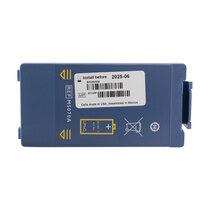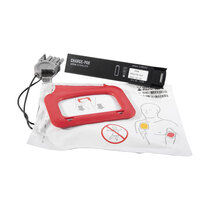-
Contact
Sales & Customer Service
0800 612 6537 support@safelincs.co.uk Live ChatDelivery Enquiries
0800 077 6149 - Resources
Fire & Safety Solutions
CALL OUR TEAM NOW 0800 612 6537
Lines open today 8am - 6pm
Free Delivery
on 100s of Products
Live Chat - Online
Instant help & Advice
Trade Discounts
and exclusive pricing
0% Credit Available
Open an account now
5 Star Customer Feedback
Defibrillator Batteries
Your defibrillator needs to be fitted with a fully powered rechargeable or non-rechargeable battery pack. Depending on the brand of your defibrillator, the battery will have a standby life, after which your battery will need replacing, regardless of whether it has been used in a rescue attempt or not. We offer a FREE reminder service so you will always have a replacement battery ready to fit into your defib, ensuring your device is ready for use in case of a sudden cardiac arrest emergency.
Zoll AED Plus Battery Pack
Used with the Zoll AED plus semi and fully automatic defibrillators, this pack of 10 non-rechargeable lithium batteries will provide power in stand-by for up to 5 years.
- Designed for use with the Zoll AED Plus Defibrillator
- Pack of 10 Duracell 123a lithium batteries
- Lifespan of up to 5 years
Schiller FRED Easyport Defibrillator Battery
This non-rechargeable lithium battery is designed to power the Schiller FRED Easyport pocket size defibrillator unit, with a 5 year stand-by life and a capacity of up to 45 shocks at maximum energy.
- For use with the Schiller FRED Easyport defibrillator
- Stand-by life: 5 years
HeartSine Samaritan Paediatric-Pak - Cartridge
The HeartSine Samaritan Paediatric-Pak cartridge combines a battery and electrode pads, and is designed with a different colour and shape so it can be easily identified against the standard adult cartridge.
- Designed for use with HeartSine Samaritan PAD 350P, 360P and 500P defibrillators
- Supplied with up to 42 months' lifespan
Zoll AED 3 Defibrillator Battery Pack
Equipped with a 5 year stand-by life when installed, this disposable replacement lithium battery is designed for use with Zoll AED 3 defibrillators.
- Provides power to the Zoll AED 3 defibrillators
- Stand-by life: 5 years (after installation)
Schiller FRED Easy Defibrillator Battery
This non-rechargeable lithium battery has a capacity of 180 shocks at maximum energy when used to power the Schiller FRED Easy and Easy Life defibrillators.
- Powers the Schiller FRED Easy and Easy Life defibrillators
- Stand-by life: 6 years
Vivest X1 & X3 Replacement Battery
Keep your Vivest PowerBeat defibrillator rescue ready at all times with this non-rechargeable lithium battery. Suitable as a replacement or a spare, this battery has a capacity of up to 200 shocks.
- Designed for the Vivest PowerBeat X1 and X3 defibrillators
- Battery stand-by life: 4 years
Philips HeartStart HS1 & FRx Defibrillator Lithium Battery
Keep your Philips HeartStart defibrillators available at all times with this non-rechargeable lithium battery. Suitable as a replacement or a spare, this battery has a capacity of up to 200 shocks.
- Designed for the Philips HeartStart HS1 and FRx defibrillators
- Battery stand-by life: 4 years
Mediana HeartOn A15 Defibrillator Battery
Designed for use with the Mediana HeartOn A15 defibrillator, this non-rechargeable long life battery is provides 4 years stand-by life or a minimum of 200 shocks.
- Suitable for the Mediana HeartOn A15 Defibrillator
- 4 year stand-by life from date of manufacture
Mediana HeartOn A16 Defibrillator Battery Pack
Designed for use with the Mediana HeartOn A16 defibrillator, this replacement lithium battery pack provides a minimum of 200 shocks, or 6 hours of continous monitoring.
- Suitable for the Mediana HeartOn A16 defibrillators
- 5 year stand-by life from date of manufacture (when installed)
Defibtech Lifeline AED & Auto Standard Battery Pack
This replacement battery pack for Defibtech Lifeline AED and Auto defibrillators has a capacity of up to 125 shocks or 8 hours of continuous operation, and has a standby life of up to 5 years.
- Designed for the Defibtech Lifeline AED and Auto defibrillators
- Up to 5 year stand-by life
- Up to 125 shocks or 8 hours of operational use
DefiSign Life Defibrillator Battery Pack
Designed for use with DefiSine Life defibrillators, this replacement battery pack provides more than 140 shocks at max capacity and ensures your device is rescue ready.
- Suitable for the Defisign Life defibrillator
- Stand-by life: 6 years
Physio-Control Lifepak CR Plus CHARGE-PAK and Electrode Replacement Kit
This CHARGE-PAK and electrode kit is designed for use with the Lifepak CR Plus defib and comes with charger battery, discharger for the depleted unit and one or two sets of pads.
- Choice of kit - supplied with 1 or 2 sets of electrodes
- Includes CHARGE-PAK charger and a discharger for used unit
- Designed specifically for the Lifepak CR Plus Defibrillator
- Supplied with up to 24 months' lifespan
Physio-Control Lifepak 1000 Non-Rechargeable Lithium Battery Kit
This battery for the Physio-Control Lifepak 1000 defibrillators comes with a discharger for your old battery to ensure it can be disposed of safely.
- Designed for use with the Lifepak 1000 automated external defibrillators
- Includes battery discharger and safe disposal instructions
- Provides a standby life of 5 years
IPAD NFK200 Replacement Battery
Designed for use for the IPAD NFK200 defibrillator, this non-rechargeable lithium battery provides up to 200 shocks and has a long shelf life of 5 years (from date of manufacture).
- For use with the IPAD NFK200 semi-automatic defibrillator
- 5 year stand-by life from date of manufacture
Defibtech Lifeline View, ECG & Pro 4 Year Battery Pack
Designed to power the Defibtech Lifeline View, ECG and Pro defibrillators, this replacement battery pack has a 4 year stand-by life when installed. During use it has a capacity of up to 125 shocks or 8 hours continuous use.
- For the Defibtech Lifeline View, ECG and Pro defibrillators
- 4 year stand-by life
iPAD SP1 Defibrillator Battery Pack
Designed with a 5 year stand-by lifespan when installed, this lithium battery is designed for use with the iPAD SP1 fully and semi-automatic defibrillator.
- Designed for the iPAD SP1 fully and semi-automatic defibrillators
- Battery stand-by life: 5 years (4 year warranty)
Philips HeartStart FR3 Defibrillator Battery
This replacement battery for the Philips HeartStart FR3 defibrillator has impressive shelf and stand-by lives, and is quick and simple to install.
- For use with Philips HeartStart FR3 defibrillators
- 5 year shelf life and 3 year stand-by life
- Provides a typical shock count of 300 shocks
Physio Control Lifepak CR2 Defibrillator Battery
This replacement battery for the Lifepak CR2 defibrillators is capable of delivering at least of 103 shocks at 360 joules.
- For use with the Physio Control Lifepak CR2 defibrillators
- Battery stand-by life: 4 years
Defibtech Lifeline AED & Auto High Capacity Battery Pack
This high capacity battery pack, for use with Defibtech Lifeline AED & Lifeline Auto defibrillator, has been designed for high use operation with a capacity of up to 300 shocks or 16 hours of continuous operation.
- Suitable for the Defibtech Lifeline AED and Auto defibrillators
- Stand-by life: Up to 7 years
- Up to 300 shocks or 16 hours of operational use
Cardiac Science Powerheart G3 & G3 Plus Intellisense Non-Rechargeable Lithium Battery
The IntelliSense lithium battery has a four year operational replacement guarantee and is designed for use with the Powerheart AED G3 and G3 Plus defibrillators.
- For use with the Powerheart AED G3 & G3 Plus defibrillators
- Four your operational guarantee
- Non-rechargeable
Page 1 (20 of 22 Products)
How long do defib batteries last?
The length of ‘life’ that your AED battery has depends on the manufacturer and also if the defib has been used in an emergency as this will deplete the battery quicker than if it has been on stand-by. Once the battery has been fitted into your device it will have a standby time, generally these are 4-5 approx. years depending on the brand. However, you should always check and make a note of how long it will last before it requires replacement. We offer a FREE reminder service; you can choose to be notified by text or email to remind you to purchase a new battery.
Batteries also have what is known as a ‘shelf life’ essentially this is how long the battery can be stored without being installed in a defibrillator. These can vary from 1 year up to 5 years, depending on the manufacturer.
How to check a defibrillator battery
Most defibs have a green flashing LED to show that the defib is ready to be used; there are a few models which may show a tick or solid green circle instead. Defibs do daily, weekly and / or monthly self-checks, and if the device finds a fault, then it will show a red flashing LED or X instead. It is recommended that defibs should be visually checked on a weekly basis to make sure they are always ready to be used in an emergency.
It is recommended that you should physically check the battery regularly to make sure the battery is within its shelf life, if it is coming up to its expiry date you should order a replacement in time to make sure a new one arrives so you can swap it straight over without being without a working defib for any time.
How to dispose of a defib battery
It is very important that you dispose of your depleted defib battery responsibly. They must never be put in with your general household waste, they need to be taken to a dedicated recycling location so they can be disposed of safely. These are often found in larger supermarkets or you can contact your local council where to take it for safe disposal.
This is because even when a lithium battery no longer has any charge it is still possible for them to explode if crushed (e.g. in the back of a refuse lorry) or to enter thermal runaway when the individual cells inside the battery become too hot and will cause a fire that can easily spread. Currently there is no absolute way of extinguishing a lithium battery fire, making safe disposal a necessity.







































